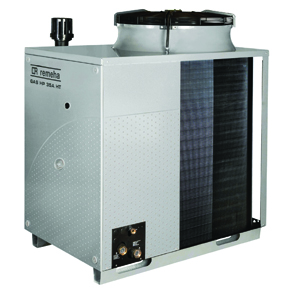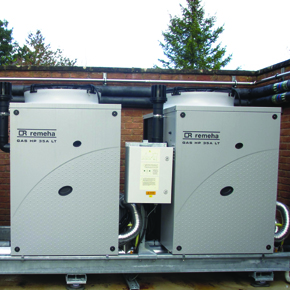
Pumping up the savings with gas absorption heat pumps
As the building services industry responds to the growing pressure to reduce energy consumption and cut carbon emissions from UK building stock, Mike Hefford, head of low carbon technologies at Remeha Commercial, looks at the carbon and energy saving benefits of gas absorption heat pumps…
If we are to meet the Government’s target of 80% carbon emission reduction by 2050, we need to improve the performance of our energy-guzzling buildings.
With space and water heating accounting for as much as 60% of the total energy use within buildings and 40% of the carbon emissions, low carbon technologies are increasingly specified for reduced energy use and a lower carbon footprint.
Amongst the range of options, gas absorption heat pumps (GAHPs) are growing in popularity as a high efficiency, low-carbon, low-NOx solution that can significantly improve the environmental ratings of a building and reduce operating costs.
GAHPs operate by capturing energy from the surrounding air, which converts to higher temperatures with the aid of an ammonia/water refrigeration cycle. GAHPs then combine this renewable energy with the gas condensing heat generator to maintain high operational efficiencies.
In this way, they can increase the thermal output to offer exceptionally high, achievable seasonal efficiencies of between 120 and 130% The high performance of GAHPs means that they deliver reliable operation even at low outside temperatures and continuous heating even in defrost operation.
The carbon factor
A key advantage of GAHPs is their use of gas rather than electricity for operation. Not only is natural gas typically around a third the price of electricity but, by using it directly at the point of use, GAHPs can provide 98% of usable heat energy use – around double that of electrically-operated heat pumps – resulting in less energy waste, lower operating costs and a smaller carbon footprint.
Improved environmental ratings
GAHPs can also significantly improve the BREEAM rating of a building. The use of ammonia, a naturally forming chemical, as the refrigerant brings two credits for zero ozone depletion potential and zero global warming potential and a third for the absence of Hydrofluorocarbons (HFC) refrigerants. Additional points come from the ability of this low carbon technology to achieve Class 5 NOx levels by using a condensing heat generator with a premixed modulating gas burner.
Flexible and versatile
Importantly, GAHPs are relatively straightforward to install and easy to operate. A key benefit of GAHPs is their suitability for use in both new build and refurbishment projects. GAHPs may be specified as a single unit or in cascade arrangement, as the primary source of clean energy or in conjunction with high-efficiency condensing boilers in a hybrid system.
Practical and affordable
On refurbishment projects, GAHPs can be easily retrofitted within an existing heating system either as a bolt-on to serviceable boilers, or in conjunction with replacement gas condensing boilers. Importantly, they require only an extremely low electrical running current to operate – just 1.09kW for a 35kW GAHP. This makes them a straightforward and affordable retrofit option as there is no need to increase the electrical incoming supply.
Mind the gap
A recent report from the Government agency, Innovate UK, found that modern non-domestic buildings routinely use 3.5 times the amount of energy they are designed to consume and produce on average 3.8 times more carbon than predicted in the design stage. Heat loss and teething problems with new technologies were some of the identified causes.
While GAHPs are relatively easy to install, good system design is essential to achieve the maximum efficiencies and savings. Look for suppliers with a thorough knowledge of the technology, who can advise on how best to maximise performance through good design, good integration and specially configured controls.
The efficiencies achievable by GAHPs – or indeed any heating technology – are dependent on a number of factors, amongst which are the ambient temperatures and flow and return temperatures, so ask for data on the achievable gas utilisation efficiency (GUE) of GAHPs at different temperatures to enable accurate calculation of their performance.
With its proven high performance and ability to deliver long-term sustainable benefits, gas absorption heat pump technology ticks all boxes, meeting the carbon requirements of Part L of the Building Regulations for new build developments and supporting the decarbonisation of heating in our existing buildings.
As the Government prepares to legislate its fifth carbon budget, encouraging a further limit in harmful emissions, it is good to know that with GAHPs we have the means to make carbon reduction in buildings a real prospect and effect positive change.
Latest news

18th April 2024
Abloy UK showcases new digital portfolio at The Security Event 2024
Abloy UK is set to unveil its latest line-up of access control systems at The Security Event 2024, welcoming guests to explore its cutting-edge electromechanical and digital solutions on stand 5/F50.
Posted in Access Control & Door Entry Systems, Architectural Ironmongery, Articles, Building Industry Events, Building Industry News, Building Products & Structures, Building Services, Doors, Exhibitions and Conferences, Facility Management & Building Services, Health & Safety, Information Technology, Retrofit & Renovation, Security and Fire Protection
18th April 2024
Strand is a Failsafe Choice for Emergency Exit and Panic Hardware
In times of emergency, you’re in safe hands with Strand Hardware. Although there are many considerations for building specification, few decisions can be as critical as selecting the right emergency exit/panic hardware.
Posted in Access Control & Door Entry Systems, Architectural Ironmongery, Articles, Building Industry News, Building Products & Structures, Building Services, Doors, Facility Management & Building Services, Health & Safety, Restoration & Refurbishment, Retrofit & Renovation, Security and Fire Protection
18th April 2024
MRA appoints Callum Budd as Research Projects Director
MRA Research, the research agency focused solely on the construction sector, welcomes Callum Budd as its new Research Projects Director.
Posted in Articles, Building Industry News, Information Technology, news, Recruitment, Research & Materials Testing
16th April 2024
Mitsubishi Electric set to host CIBSE Journal webinar
Mitsubishi Electric will host a CIBSE Journal webinar on Wednesday 24th April 2024 at 1pm to discuss the legislation and initiatives driving changes in the way we will need to heat, cool and ventilate large commercial buildings to reach net zero emissions in the UK.
Posted in Air Conditioning, Articles, Building Industry Events, Building Industry News, Building Products & Structures, Building Regulations & Accreditations, Building Services, Facility Management & Building Services, Heating Systems, Controls and Management, Heating, Ventilation and Air Conditioning - HVAC, Information Technology, Pipes & Fittings, Plumbing, Seminars, Sustainability & Energy Efficiency, Training
 Sign up:
Sign up: 